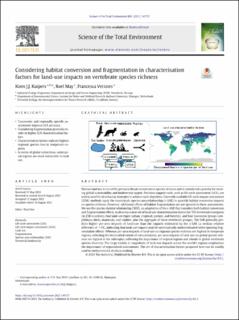| dc.description.abstract | Human land use is one of the primary threats to terrestrial species richness and is considered a priority for meeting global sustainability and biodiversity targets. Decision-support tools, such as life cycle assessment (LCA), are widely used for developing strategies to achieve such objectives. Currently available life cycle impact assessment (LCIA) methods apply the countryside species-area relationship (c-SAR) to quantify habitat conversion impacts on species richness. However, additional effects of habitat fragmentation are yet ignored in these assessments. We use the species-habitat relationship (SHR), an adaptation of the c-SAR that considers both habitat conversion and fragmentation effects, to develop a new set of land-use characterisation factors for 702 terrestrial ecoregions (in 238 countries), four land-use types (urban, cropland, pasture, and forestry), and four taxonomic groups (amphibians, birds, mammals, and reptiles; plus the aggregate of these vertebrate groups). The SHR generally predicts higher per-area impacts of land-use than the impacts estimated by the c-SAR (a median relative difference of +9%), indicating that land-use impacts may be systematically underestimated when ignoring fragmentation effects. Whereas per-area impacts of land-use on regional species richness are highest in temperate regions, reflecting the diminished extent of natural habitat, per-area impacts of land-use on global species richness are highest in the subtropics, reflecting the importance of tropical regions and islands to global vertebrate species diversity. The large variety in magnitude of land-use impacts across the world's regions emphasizes the importance of regionalised assessments. The set of characterisation factors proposed here can be readily used in environmental decision-making. | en_US |

